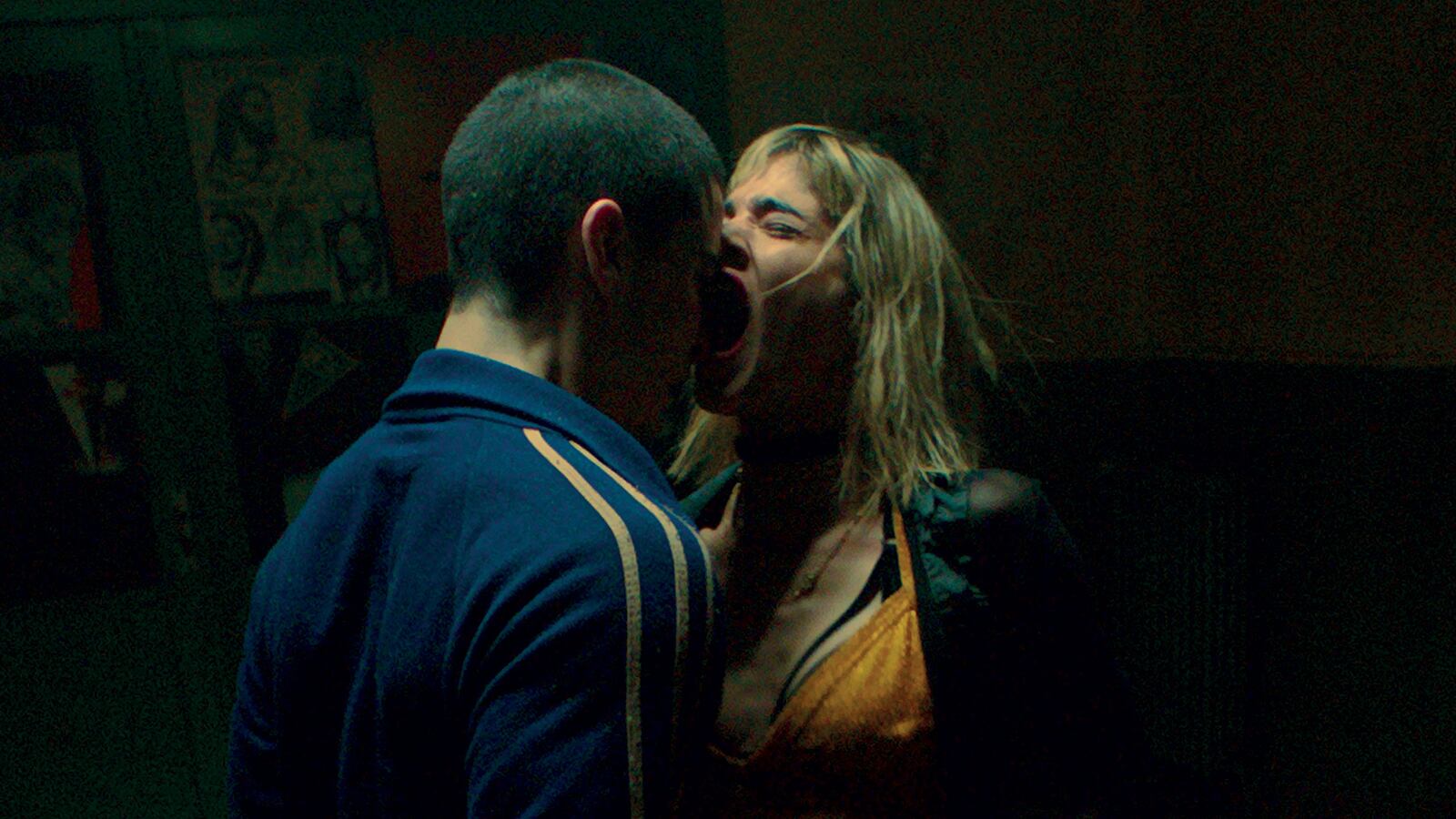Gaspar Noé doesn’t make movies for the masses—or, for that matter, for the critics, who’ve often taken him to task for provocatively pushing boundaries in films such as 2002’s Irréversible (a rape-revenge saga marked by an infamous nine-minute rape sequence) and 2015’s Love (an NC-17 relationship drama with up-close-and-personal 3D ejaculation). So when his latest, Climax, about a multicultural troupe of dancers driven mad by some LSD-spiked punch, was greeted with widespread acclaim at last year’s Cannes Film Festival, the 55-year-old French auteur wasn’t quite sure how to handle it.
“I didn’t expect it, because I’ve gotten used to [receiving] many more bad reviews than good reviews,” he admits a week before the film’s March 1 stateside debut. With Climax, “sometimes people come out and say, oh, this movie shocked me, and it reminded me of the worst blackouts in my life, I have to go home. Or people who have kids get far more scared than most people. But mostly, even if the movie’s traumatic, people have come out smiling. It’s weird.”
That isn’t to say, however, that the gregarious Noé doesn’t have a theory about why Climax has become arguably his most well-received feature to date.
“In this case, what we managed well was that we shot the movie and no one knew at all that I was shooting a movie or what it was about at Cannes,” he explains. “Even in the Director’s Fortnight catalog, it said nothing about the movie. I asked, can we hide what the movie is about until the day of the screening? So I just wrote a synopsis: ‘Birth and death are extraordinary experiences. Life is a fleeting pleasure.’ I think critics who saw the movie, they were not prepared to see the movie, and it helped them. Also, the dancing aspect of the movie, and the charisma, and the incredible acrobatic skills of the dancers, made it friendlier than my previous movies, which were dealing with tormented people.”
Relative to his past outrageous output, Climax is the tamest film of Noé’s career, to the point that its most shocking demise happens off-screen, and no male or female full-frontal nudity is seen. When asked why he opted for this (somewhat) more toned-down approach, he claims it was the drugs’ fault—literally.
“When people are drunk or wasted, they become sexually dysfunctional,” Noé maintains. “Sometimes, it happens during dinner—you seduce someone, or someone seduces you, and you have one, two, three drinks, and when the moment comes to kiss, you can barely kiss. And then half an hour later, all your sexual ideas are falling into pieces because you just want to go crash on your bed. In this movie, it’s like that. I don’t think anybody has the possibility to fulfill their sexual project, because they can barely say what their name is.”
Lest you think Climax is just a walk in the park, however, let it be known that Noé’s film is a trance-like dance movie that descends into hellish chaos—and is thus wholly in tune with his prior work. Beginning at the conclusion, with the image of a screaming woman collapsed in snow that’s overlaid by the end credits, and then rewinding backwards to recount the events that led up to that fateful sight, Noé’s tale is based, he says, on an actual 1996 incident in which a group of dancers got together for a rehearsal at which they all unwittingly embarked on a very bad acid trip. That basic premise remains, although the director cared little about the particulars of the real-life event when turning it into a fictional drama.
“It’s an open adaptation,” he acknowledges. “It’s about dancers in a school and everything turns wrong. But I’m sure that the dancers in that [real-life] event were not dancing like the dancers that I portray in the movie. I wanted the most cinematic dancers. I didn’t even check the family origins or sexual tendencies or anything else [of the real-life people in question]—it was not an issue. I decided, OK, let’s do this thing in a school, and everything turns wrong, but I decided to do a far more free movie with the most charismatic and fascinating dancers I could find around Paris.”
Save for Sofia Boutella (best known as the undead fiend in Tom Cruise’s ill-fated The Mummy) and Souheila Yacoub, most of the performers in Climax are non-professionals. Their uninhibited turns are key to the proceedings’ manic thrust, and Noé’s camera—often in amazingly extended single takes—twirls in and around his various subjects chatting about sex, drugs, love and camaraderie, as well as engaging in blistering, flailing choreographed numbers set to the sounds of Daft Punk, Aphex Twin and Soft Cell. What the director performs is nothing short of his own cinematographic dance routine, so intensely attuning his frame’s swirling, gliding movements to those of his artist characters that the two wind up feeding off each other’s sensual, serpentine energy.
“My best partner in crime is my cinematographer, Benoît Debie. Sometimes I do the camera, sometimes he does it. In this movie, I said I need to be close to the actors and dancers all the time, because things are going to change, and I don’t want to make someone else responsible for moving the camera to the right while I thought that the things that were happening on the left were more interesting,” Noé says. Plus, given that he was working with many individuals who’d never acted before, “I knew that they would feel much safer if it was just me behind the camera, one meter away from them, telling them to shout louder or to dance faster.”
For a film marked by increasingly dark, demented turmoil, it’s little surprise to hear that Climax came to life in an explosive creative flash. Noé conceived, preproduced and cast the project in a month, shot it in 15 days, and edited it in less than two months—meaning its entire lifespan, from initial idea to Cannes premiere, was four months. “It was not even half of the time that a woman needs to bring a baby to the world. The day we saw the movie, me and my producers, my technicians and my dancers, couldn’t believe that it had happened so quickly.”
That blistering pace clearly contributed to the deliriousness of the material itself, and Noé stresses the reason for such a rushed production had to do with the issue of freedom. “I shot it that fast because we had no script. I asked my producers, how much money can you give me to make a movie with no script? They said if you can shoot it in two weeks, we can probably finance the shooting, but then we need to find money for the post-production. So we started shooting almost in an unconscious way. The less money you take for the movie, the more freedom you have. If I had written every detail and everything in the dialogue, for sure, every person on this planet would have made recommendations to cut this, or to rearrange that, to make the movie better. That’s why I like making a movie with almost no script better—no one can tell me in advance how to do it.”
“There is a thing called good energy and bad energy, but there are kinds of energies that are very creative, and that happened. The excitement of other people excites you at the same time. So it was like a party that never turned wrong. All my movies in the past, there were tensions, financial tensions, tensions with someone. But there were none here. This experience was the happiest experience with filming that I ever had.”
The result is a protracted freak-out that oozes sweaty mania from its every pore, especially as the drugs kick in and the unsuspecting dancers find their most terrified, angry, and ugly impulses seeping out of their subconscious and into their behavior. In that regard, Climax plays like an unconventional horror film, replete with a Suspiria-like plummet into a psychosexual abyss—a description that’s bolstered by the fact that Noé introduces his characters via interviews spied on an old TV surrounded by some of his favorite VHS tapes, including Possession, Zombie (the French title for George A. Romero’s Dawn of the Dead), and Argento’s 1977 classic, which was remade last year by Luca Guadagnino.
For Noé, those genre shout-outs are his figurative cameo in Climax: “That moment is like me sitting in front of my TV 25 years ago.” While the horror title which most influenced his latest isn’t seen on-screen (Shivers, which he didn’t own a VHS copy of during shooting), he confesses that the real inspirations for his collapsing-collective narrative were disaster epics such as The Towering Inferno and The Poseidon Adventure, in which a group of random people are forced to contend with catastrophic circumstances. “It’s all about who’s going to survive and who’s going to die. In those very popular and commercial movies of the ‘70s, the cruel character would always die before the end. In real life, it’s the more fragile people who die first—the babies, the old people.”
Climax certainly delivers on that sort of bleakness, via a conclusion that leaves few unscarred. Ask Noé about his fondness for flirting with (if not outright indulging in) extremeness, however, and he’s quick to counter that, in light of his favorite filmmakers—including Stanley Kubrick, a long-time touchstone—he views himself as pretty tame.
“If I see all the books and DVDs I have at home, most of them were considered strong movies and strong books, controversial,” he states. “Compared to my idols, I’m very soft.”






